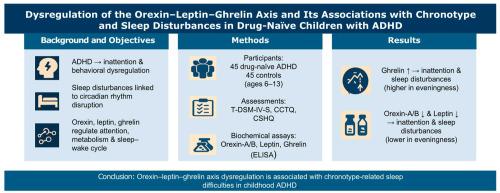Dysregulation of the orexin–leptin–ghrelin axis and its associations with chronotype and sleep disturbances in drug-naïve children with ADHD
IF 3.4
2区 医学
Q1 CLINICAL NEUROLOGY
引用次数: 0
Abstract
Attention Deficit Hyperactivity Disorder (ADHD) is a neurodevelopmental disorder defined by inattention and behavioral dysregulation. Sleep disturbances are frequently reported in ADHD and strongly associated with circadian rhythms and sleep–wake regulation. Given the pivotal involvement of orexin, leptin and ghrelin systems in the modulation of cognitive, metabolic and circadian functions, this study aimed to investigate whether serum orexin-A, orexin-B, leptin and ghrelin levels are associated with chronotype and sleep disturbances in children with ADHD. Forty-five drug-naïve ADHD patients and 45 age and sex-matched healthy controls were assessed using validated measures of chronotype and sleep habits, and serum hormone levels were analyzed via two-site sandwich ELISA. Children with ADHD exhibited substantially higher eveningness chronotype, as well as markedly elevated bedtime resistance, sleep onset delay, night wakings and daytime sleepiness (all p < 0.001). Importantly, serum orexin-A (p < 0.001), orexin-B (p = 0.039) and leptin (p = 0.012) levels were significantly reduced in the ADHD group, whereas serum ghrelin levels were significantly increased (p < 0.001). Ghrelin levels showed strong positive associations with attention deficit scores, chronotype scores and total sleep disturbance scores (all p < 0.01), whereas orexin-A/B and leptin levels were negatively correlated with these parameters (all p < 0.05). Notably, children with an evening chronotype showed the highest ghrelin and lowest orexin/leptin levels. To our knowledge, these findings provide preliminary evidence of an association between disturbances in the orexin–leptin–ghrelin axis and chronotype-related circadian misalignment and sleep difficulties in childhood ADHD, suggesting that neurohormonal mechanisms may be relevant to the underlying pathophysiology.

drug-naïve多动症儿童食欲素-瘦素-饥饿素轴的失调及其与睡眠障碍的关系
注意缺陷多动障碍(ADHD)是一种以注意力不集中和行为失调为特征的神经发育障碍。睡眠障碍经常被报道为ADHD患者,并且与昼夜节律和睡眠-觉醒调节密切相关。鉴于食欲素、瘦素和胃饥饿素系统在认知、代谢和昼夜节律功能调节中的关键作用,本研究旨在探讨血清食欲素- a、食欲素- b、瘦素和胃饥饿素水平是否与ADHD儿童的时间型和睡眠障碍有关。45名drug-naïve ADHD患者和45名年龄和性别匹配的健康对照者使用经过验证的时间型和睡眠习惯测量方法进行评估,并通过双向夹心ELISA分析血清激素水平。ADHD儿童表现出明显较高的夜性时间型,以及明显升高的就寝阻力、睡眠开始延迟、夜间醒来和白天嗜睡(均p
本文章由计算机程序翻译,如有差异,请以英文原文为准。
求助全文
约1分钟内获得全文
求助全文
来源期刊

Sleep medicine
医学-临床神经学
CiteScore
8.40
自引率
6.20%
发文量
1060
审稿时长
49 days
期刊介绍:
Sleep Medicine aims to be a journal no one involved in clinical sleep medicine can do without.
A journal primarily focussing on the human aspects of sleep, integrating the various disciplines that are involved in sleep medicine: neurology, clinical neurophysiology, internal medicine (particularly pulmonology and cardiology), psychology, psychiatry, sleep technology, pediatrics, neurosurgery, otorhinolaryngology, and dentistry.
The journal publishes the following types of articles: Reviews (also intended as a way to bridge the gap between basic sleep research and clinical relevance); Original Research Articles; Full-length articles; Brief communications; Controversies; Case reports; Letters to the Editor; Journal search and commentaries; Book reviews; Meeting announcements; Listing of relevant organisations plus web sites.
 求助内容:
求助内容: 应助结果提醒方式:
应助结果提醒方式:


